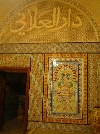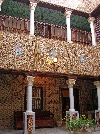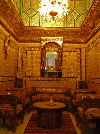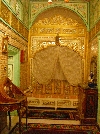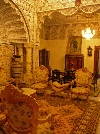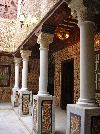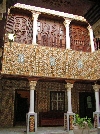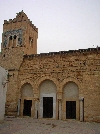
Tunisia Odyssey: Historic North
Bicycle Africa / Ibike
Tours
Dispatch 9 - Kairouan
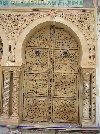 We had a lazy start today as we did not need
to be at the bus station until a bit after 11 am. After the bikes were
loaded on top, for three hours we took the bus east to Kairouan, Islam’s
fourth holiest city (at least by Tunisian Muslim tradition). Tunisians
will tell you that three pilgrimage to Kairouan are equal to a pilgrimage to
Mecca. It is also known as the "city of three hundred mosques."
We had a lazy start today as we did not need
to be at the bus station until a bit after 11 am. After the bikes were
loaded on top, for three hours we took the bus east to Kairouan, Islam’s
fourth holiest city (at least by Tunisian Muslim tradition). Tunisians
will tell you that three pilgrimage to Kairouan are equal to a pilgrimage to
Mecca. It is also known as the "city of three hundred mosques."
The bus was comfortable and modern. As tourism has grown in Tunisia, the tour companies have purchased larger more modern buses (often used from European operators who are buying even larger and more modern buses). With new rolling stock ,the Tunisia tour operators sell there older buses, which get a third life when the transit agencies snatch them up for public transportation on their longer routes. We got one of these hand-me-downs.
The countryside started out looking like the last several days: green farmland with lots of wildflowers, but gradually became drier. I was again impressed with the size and health of the prickly pear cacti here. We were the only foreigners on the bus, and it was interesting watching the comings and goings of the locals as we made a few stops in towns along the way. The guess on the old man in the burnoose (traditional cape) is he was heading to Kairouan on pilgrimage; he had the feel of a pilgrim -- but much of this could be from stereotypes about the dress of pilgrims. This man was dressed in a fairly typical style for older Tunisian men and he, in fact, could be coming or going from a visit to his children or grandchildren.
Had we not been imprisoned in a bus there were several places that warranted further investigation: Eight kilometers west of Le Ser is a Tunisian-Canadian mining operation, but it is not clear what the objective is. Le Sers, itself, is a growing from a country town to a country city. With a little stroll we could have gotten a feel for the town. We picked up a few students here who disembarked a various cross-roads as we got back out into the countryside. There are couple marble quarries just off the road. This is the area where the only green marble in North Africa is found. The biggest town is Maktar; Roman Mactaris. At 900m (3000 ft) it is also the highest town in Tunisia. It also has a rich history. From the forth century BC until the eleventh century AD is was successively inhabited by Neolithic, Lybic, Numidian, Roman, Byzantine people. The is substantial physical history to be seen in the archeological park, including: dolmans and Roman basillica, baths, arch, forum, temples of Bacchus, Schola (men’s club), wealthy residential area. We next passed, without exploration, the mountain top village of Kasra. The oldest continually occupied village in Tunisia. Descend back to the agricultural plains we passed through the agricultural town of Haffouz.

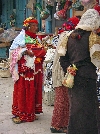 At
the end we alit at Kairouan, affixed our pedals and
gear, and assailed the task of finding our hotel. We cut straight
through the extensive medina
At
the end we alit at Kairouan, affixed our pedals and
gear, and assailed the task of finding our hotel. We cut straight
through the extensive medina
 (old walled town) now a complex with a mix of
tourist and regular shops, residential, light industry (weaving, woodworking, metal work,
pottery,
etc) and mosques. A quick list of what is for sale
(old walled town) now a complex with a mix of
tourist and regular shops, residential, light industry (weaving, woodworking, metal work,
pottery,
etc) and mosques. A quick list of what is for sale
 in a couple blocks
in a couple blocks of
the market includes: women's clothes,
baby clothes, hip teen clothes, men's clothes, jewelry, musical instruments,
dishes, leather goods, sheep skins, rugs, blankets,
of
the market includes: women's clothes,
baby clothes, hip teen clothes, men's clothes, jewelry, musical instruments,
dishes, leather goods, sheep skins, rugs, blankets,
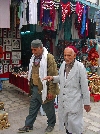 scarves, baskets, fruits,
scarves, baskets, fruits,
 vegetables, spices, grains
in bulk, can goods, packaged goods, bread, pastries, water pipes, shoes,
sandals, soap, shampoo, perfume, toiletries.
vegetables, spices, grains
in bulk, can goods, packaged goods, bread, pastries, water pipes, shoes,
sandals, soap, shampoo, perfume, toiletries.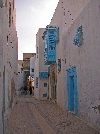



 Our hotel was just a block beyond the outer wall on the far side of the
media. The wall has been destroyed and rebuilt
seven times. The were originally earth wall. Current alignment set
during the revival of the city by Bey Hussein
ibn Ali Turki in 1706. From 1758 to 1772 Husanynite (Ali Pasha
II) rebuilt wall. The wall is 3.8 km, 4-8 meters high, 2.7 meters thick
-- strongest at
the gates and bastion. The wall was total restoration
in the 1990's
Our hotel was just a block beyond the outer wall on the far side of the
media. The wall has been destroyed and rebuilt
seven times. The were originally earth wall. Current alignment set
during the revival of the city by Bey Hussein
ibn Ali Turki in 1706. From 1758 to 1772 Husanynite (Ali Pasha
II) rebuilt wall. The wall is 3.8 km, 4-8 meters high, 2.7 meters thick
-- strongest at
the gates and bastion. The wall was total restoration
in the 1990's
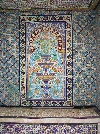
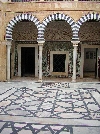 After check-in, we dumped our gear and went
for a walk. One member of the group was especially interested in purchase some
Tunisian carpets and Kairouan is a great
place to accomplish this, so we headed off to one of the dealers
here. In route we stopped to tour the zaouia (Islamic school and tomb complex) of Sidi
Abu Samir Abid
el-Ghariani, a disciple of the founder and his successor, who lived in the
late 14th century. The building was built in the 9th or 14
After check-in, we dumped our gear and went
for a walk. One member of the group was especially interested in purchase some
Tunisian carpets and Kairouan is a great
place to accomplish this, so we headed off to one of the dealers
here. In route we stopped to tour the zaouia (Islamic school and tomb complex) of Sidi
Abu Samir Abid
el-Ghariani, a disciple of the founder and his successor, who lived in the
late 14th century. The building was built in the 9th or 14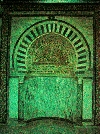 th
century, depending upon the source, but this may be a confusion between the
construction of the building and the start of the zaouia. There is more
information about the 14th century activities. This is interesting
because that was sort of a dark ages period of Kairouan history. The
zaouia was founded by Sayh
Abu 'Abd Allah Muhammad b. 'Abd Allah b. Abd al-Aziz al Sba'i (a.k.a.
Aljedidi), who died 1386. The
building materials (ringed pillars, capitals and the kufic inscriptions)
came from the Fatimid site of Sabra al-Mansouriyya.
th
century, depending upon the source, but this may be a confusion between the
construction of the building and the start of the zaouia. There is more
information about the 14th century activities. This is interesting
because that was sort of a dark ages period of Kairouan history. The
zaouia was founded by Sayh
Abu 'Abd Allah Muhammad b. 'Abd Allah b. Abd al-Aziz al Sba'i (a.k.a.
Aljedidi), who died 1386. The
building materials (ringed pillars, capitals and the kufic inscriptions)
came from the Fatimid site of Sabra al-Mansouriyya.
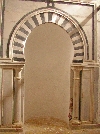 The
building is made up of the mausoleum, oratory and Medersa (residential school).
The prayer halls can be
identified by the inlayed Turkish (horseshoe) arches at the mirabs.
There
The
building is made up of the mausoleum, oratory and Medersa (residential school).
The prayer halls can be
identified by the inlayed Turkish (horseshoe) arches at the mirabs.
There
 were
a couple of intricate wood ceilings. Some were painted and others were
carven and bare. The zaouia also contains the
tomb of Hafsid ruler Moulay Hassan. In addition to the deceased Hassan,
ts current tenants are the Association for the
Safeguard of the Median of Kairouan and the regional branch of the National
Institute of Archaeology and Art. On the whole, this zaouia seems modest
compared to others that we saw.
were
a couple of intricate wood ceilings. Some were painted and others were
carven and bare. The zaouia also contains the
tomb of Hafsid ruler Moulay Hassan. In addition to the deceased Hassan,
ts current tenants are the Association for the
Safeguard of the Median of Kairouan and the regional branch of the National
Institute of Archaeology and Art. On the whole, this zaouia seems modest
compared to others that we saw.
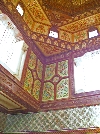
 The carpet dealer was housed in the
Maison du
Gouverneur, house of the former beys or pashas from the eighteenth century.
Before the carpet showing, we were given a tour of the
The carpet dealer was housed in the
Maison du
Gouverneur, house of the former beys or pashas from the eighteenth century.
Before the carpet showing, we were given a tour of the house which is
exquisite with the colorful tiles, elegant latticework and elaborate
ceilings. The north side is public
rooms for receiving guests and the south side is private for the family and
house which is
exquisite with the colorful tiles, elegant latticework and elaborate
ceilings. The north side is public
rooms for receiving guests and the south side is private for the family and harem, and includes a music room. The building was nationalized in 1956,
when the Pasha was sent back to Turkey.
harem, and includes a music room. The building was nationalized in 1956,
when the Pasha was sent back to Turkey.
 To really appreciate it, you should just sit still
for awhile in each room and gawk; you can’t begin to take
To really appreciate it, you should just sit still
for awhile in each room and gawk; you can’t begin to take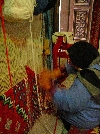 it all in on a
walk through. As part of the tour we saw a carpet being woven and other partly
finished. Kairouan carpets are knotted and woven by women, usually in their house,
from memory (no patterns, nothing drawn on the loom), and the work very
quickly. Other types of carpet that are also available are mergums
which are woven and
embroidered by Berber women and kilim are woven by Berber.
it all in on a
walk through. As part of the tour we saw a carpet being woven and other partly
finished. Kairouan carpets are knotted and woven by women, usually in their house,
from memory (no patterns, nothing drawn on the loom), and the work very
quickly. Other types of carpet that are also available are mergums
which are woven and
embroidered by Berber women and kilim are woven by Berber.
 Back at the carpet display room, the fun
began, we are served mint tea and the salesman explaining the finer aspects of his carpets. From
our perspective, the salesman went far
too fast through his spiel and was out of touch with his audience. Our
buyer was getting overwhelmed and frustrated.
The salesman and staff were trying to rush us through even though one man had stated up front he was interested in buying several carpets.
There were more traditional complementary glasses of thé and the
flourishing of carpets. There was one comment that
prices seemed considerably less than those he had seen in Turkey, but the
weaving technique was different as well.
Back at the carpet display room, the fun
began, we are served mint tea and the salesman explaining the finer aspects of his carpets. From
our perspective, the salesman went far
too fast through his spiel and was out of touch with his audience. Our
buyer was getting overwhelmed and frustrated.
The salesman and staff were trying to rush us through even though one man had stated up front he was interested in buying several carpets.
There were more traditional complementary glasses of thé and the
flourishing of carpets. There was one comment that
prices seemed considerably less than those he had seen in Turkey, but the
weaving technique was different as well.
 After
more than an hour comparing and contrasting and adjusting and looking for
something slightly different, slightly bigger, slightly smaller, etc., the deal was closed on
a five carpets purchase. In celebration, the
buyer brought
a collection of local delicacies for supper including makhroud, the
signature cookie of Kairouan. These bite sized dainties are semolina cake
with a date center which is soaked in honey and oil. They are tasty. An
important lesson: if you have makhroud and
mint thé for dessert drink your
thé before eating your dessert – it’ll taste a whole lot better in
this order.
After
more than an hour comparing and contrasting and adjusting and looking for
something slightly different, slightly bigger, slightly smaller, etc., the deal was closed on
a five carpets purchase. In celebration, the
buyer brought
a collection of local delicacies for supper including makhroud, the
signature cookie of Kairouan. These bite sized dainties are semolina cake
with a date center which is soaked in honey and oil. They are tasty. An
important lesson: if you have makhroud and
mint thé for dessert drink your
thé before eating your dessert – it’ll taste a whole lot better in
this order.
Those who stuck around to the end bargaining got a tour of another one of the Pasha's family's opulent mansions on the same street. This one was not used as a shop and was more furnished in period furnishings.
At supper (pictured below are Tunisian tajine (soufflé), ojja (pouched eggs in spiced tomato sauce), and mechioua (roasted pepperand tomato salad), we were briefed us on Kairouan’s history to prepare us for a tour of some of the distinctive sites in Kairouan.
To set the state: It was the Byzantine Period (533-698), in the north and along coast, and the Christian Berber Ifriqiya Period (647-698) in the southern interior. Back on the Arabian pennisula, Mohammad flees Mecca to Medina in 622. The dispersion of Islam started in earnest about a decade later. The first Arab reconnaissance mission arrived in Tunisia fifteen years later, 647, and plunder Sbeitla, to the southwest of present day Kairouan. The site of Kairouan was mostly a desolate sandy plain at the time.
In AD 670, Oqba ben Nafi's horse stumbled over a golden goblet/chablis that had gone missing in the holy well Zem-Zem in Mecca some years earlier. When the Arab general picked up the goblet a spring appeared. As legend has it, the water from this spring is connect underground to the same source as the Zem-Zem.
 Oqba
b. Nafi founded Kairouan on the site and the city administratively linked to Egypt
from 670-698. Bi'r Ruta (Barruta Well) now marks the location of the
miraculous find.
Oqba
b. Nafi founded Kairouan on the site and the city administratively linked to Egypt
from 670-698. Bi'r Ruta (Barruta Well) now marks the location of the
miraculous find.
 The first
historic mention of Bi'r Ruta s in the 11th C AD. The present building dates from the Muradite period (c1700’s)
and is now quite touristy, complete with post card and carpet sellers.
The first
historic mention of Bi'r Ruta s in the 11th C AD. The present building dates from the Muradite period (c1700’s)
and is now quite touristy, complete with post card and carpet sellers.
 The sacred water is now drawn by a camel decked out in colorful
scarves and
visitors are welcome to dip out a cup of water to drink. Many Muslims
consider this the culmination of a pilgrimage to Kairouan, and it is revered in
the Islamic community -- particularly North African Muslims.
The sacred water is now drawn by a camel decked out in colorful
scarves and
visitors are welcome to dip out a cup of water to drink. Many Muslims
consider this the culmination of a pilgrimage to Kairouan, and it is revered in
the Islamic community -- particularly North African Muslims.
The Berbers didn't exactly put out a welcome mat for the immigrants from the east and their new religion. In fact there was fierce resistance and a series of scurmishes. In 683, Berbers led by Kysala ambush and kill Oqba b. Nafi at Tahuda (near Biskra in Algeria) and the Arabs were driven out of Tunisia. In 684, King Kysala made Kairouan the capital of Ifriqiya. This conditions only lasted eight years, when Arabs under Hassan b. al-Nu'man defeat last stronghold Berber Queen Kahina, at El Jem. In 694, Arabs refounded Kairouan. Life wasn't all peace and tranquility because the Kahina's insurrection continued in outlying areas. The arab conquest wasn't complete until 698 when al-Nu'man defeated El Kahina near Gabes. For the next century the was continued development of the town: From 722-728, Yazid b. hatim al-Muhallabi organized the souk (market): souk al-Ahad (Sunday souk), souk Isma'il, al- Qaysariyya, souk al-Bazzazin (cloth), souk al-Khazzazin (silk), souk al Zaggagin (glassware), souk al-Sayarifa (money changers), souk al-Sarragin (saddlers). From 762-763 a wall with six gates was built to protect the town. By 800, Kairouan had become a center of Arab-Islamic scholarship.
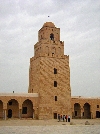 The
mid-ninth century saw a number of enduring civic improvements in Kairouan.
The original small mosque, built in 670, was torn down and rebuilt
three times over the next century.
The minaret is probably the work of
The
mid-ninth century saw a number of enduring civic improvements in Kairouan.
The original small mosque, built in 670, was torn down and rebuilt
three times over the next century.
The minaret is probably the work of
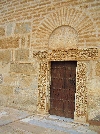 Bishr b. Safwan
(721-728 AD). It is in the style of Umayyad Syria. Ancient blocks used at the base,
with carefully hewn quarry stones above. Door jambs and lintel made from
ancient Roman friezes and soffits. 10.5 meters wide at the base and 31.5 meters
high. Three stories crowned by a cupola set on a squinch -- 129 steps.
It was used both for the call to prayer and as a military lookout. In 836,
a larger prayer was built, which became the heart the great mosque of Kairouan.
Bishr b. Safwan
(721-728 AD). It is in the style of Umayyad Syria. Ancient blocks used at the base,
with carefully hewn quarry stones above. Door jambs and lintel made from
ancient Roman friezes and soffits. 10.5 meters wide at the base and 31.5 meters
high. Three stories crowned by a cupola set on a squinch -- 129 steps.
It was used both for the call to prayer and as a military lookout. In 836,
a larger prayer was built, which became the heart the great mosque of Kairouan.

 In 862, the prayer
hall was extended and the cupola was built over central nave. Over the
next century the great doors were added and the ceiling was repainted and
decoration with foliated scrolls. Later history of the mosque is covered below.
In 862, the prayer
hall was extended and the cupola was built over central nave. Over the
next century the great doors were added and the ceiling was repainted and
decoration with foliated scrolls. Later history of the mosque is covered below.
 A
century and a quarter earlier the Syrian Umayyad caliph ordered his governor in Ifriqiya to
build 15 reservoirs. In 860, the Aghlabids improved and added new
waterworks -- filled by water from Marguellil River. Pavilions were
built over the center to provide a cool retreat for the elite. Today, only
four remain, the rest are lost.
A
century and a quarter earlier the Syrian Umayyad caliph ordered his governor in Ifriqiya to
build 15 reservoirs. In 860, the Aghlabids improved and added new
waterworks -- filled by water from Marguellil River. Pavilions were
built over the center to provide a cool retreat for the elite. Today, only
four remain, the rest are lost.
The Masgid b. Khayrun (Mosque of Three Doors) was built in 866 by an Andulcian
exile. It's known for its elaborately decorated 9th C facade.
Three bands of inscription mention the date of the building, the name of its
founder and the third, written in coarser script indicates the date when the mosque was restored and the minaret added. The middle register is decorated
with floral motifs composed of demi-palmettes.
 The
founder of this mosque came from Cordoba, Spain hence its Andalusian look.
The story of the doors is that one was for men, another for women and the
third for children. The mosque, though restored, is not currently
used.
The
founder of this mosque came from Cordoba, Spain hence its Andalusian look.
The story of the doors is that one was for men, another for women and the
third for children. The mosque, though restored, is not currently
used.
The third enduring building of this period is the royal town of Raqqada, 10 kilometers south of Kairouan, constructed around 870, under Emir Mohammed II. The palace eventually became a formal presidential palace for President Habib Bourguiba. It is now the Raqqada National Museum of Islamic Art. The exhibits include:
- Ceramics Room: With collections from Aghlabid (9th C) and Fatimid (10th C) pieces.
- Coin Room: The inscription on the coins provide information on certain aspects of economic life and constitute a barometer of the economy, quality of metal employed, weight, date and place of minting,
- Cupola Room: Displaying glassware (decanters, tumblers, perfume flasks, sprinklers, lamps and early hegira era coins); lead (weights bearing seal of the governor or prince, guaranteeing the authenticity of the weight); and bronze chandeliers (from the great mosque in Kairouan, 11th C).
- Koran Room: These Kairouan mosque parchments, by their number and quality, constitute on of the finest and rarest collections of the Islamic world.
The next century brought a lot of change to Tunisia. 909 AD was the start of the Fatimid dynasty -- adherents of the more conservative Shiism, believing that only the descendents of Ali and Fatima are "true caliphs". The felt that the Islamic world had gone astray. In 912, they moved the capital to Mahdia (and eventually to Cairo).
At the same time, in 911 there was an earthquake, in 919 the souk was hit by a major fire, and in 920 there were devastating floods.
Once the Fatimid had established themselves in Cairo they turned the administration of Tunisia over Sunni, Algerian/Tunisian Berbers, who formed the Zirid dynasty (973-1051). One artifact of this period is a small cemetery near the Great Mosque. It is a Berber family plot, possibly established in the 10th C. The patriarch is said to have had 12 wives.
An even bigger disaster struck in 1057 in the form of Beni Hilla, Arab nomads from Egypt, and his followers. They ousted the Zirids, razed Kairouan and pillaged the country for four years.
The record is then pretty blank until the Husaynid dynasty, when Kairouan was again occupied, fully restored, and reemerged as the spiritual center of Tunisia.

 One
of the first enduring buildings of the rejuvenation of Kairouan is the Abu Zam'a al-Balawi Mausoleum - a.k.a. Mosque of
the Barber. The mausoleum
contains the tomb of Abu zam'a Ubayb b. al-Arquam
al Balawi, one of the companions of the prophet Mohammed. Abu Zama is said to have kept three hairs
of the prophet's beard, with which he is
buried. He died 654 AD and presumably was buried within three days,
but it is not clear where he died and this was 16 years before Oqba b. Nafi
discovered the challis at the future Kairouan. The mausoleum housing the tomb, the cupola and the courtyard
are the work of the Muradite Bey, Hammouda Pacha (r. 1631-66).
One
of the first enduring buildings of the rejuvenation of Kairouan is the Abu Zam'a al-Balawi Mausoleum - a.k.a. Mosque of
the Barber. The mausoleum
contains the tomb of Abu zam'a Ubayb b. al-Arquam
al Balawi, one of the companions of the prophet Mohammed. Abu Zama is said to have kept three hairs
of the prophet's beard, with which he is
buried. He died 654 AD and presumably was buried within three days,
but it is not clear where he died and this was 16 years before Oqba b. Nafi
discovered the challis at the future Kairouan. The mausoleum housing the tomb, the cupola and the courtyard
are the work of the Muradite Bey, Hammouda Pacha (r. 1631-66).
 The
minaret and the medersa were built
The
minaret and the medersa were built
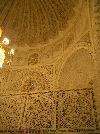 by Mohammed b. Murad in 1685-1690. The
building shows both Ottoman (Turkish) and Andalusia (Spanish) styles (tile, painting,
plaster and woodwork) and is noted for its interior craftsmanship.
by Mohammed b. Murad in 1685-1690. The
building shows both Ottoman (Turkish) and Andalusia (Spanish) styles (tile, painting,
plaster and woodwork) and is noted for its interior craftsmanship.
 The
filigree and bright tiling are reminiscent of the magnificent Moorish mosques in
southern Spain. As nonbelievers, we were not allowed into the mausoleum itself,
but could peek in from outside. The gregarious guardian sprinkled our heads and
hands with rosewater for refreshment though. This is Tunisia's most
frequently visited mausoleum. Visitors come from all over North Africa to
make vows or celebrate weddings or circumcisions. The official celebration
of the Mouled, commemorating the birth of the Prophet, is held here each
year.
The
filigree and bright tiling are reminiscent of the magnificent Moorish mosques in
southern Spain. As nonbelievers, we were not allowed into the mausoleum itself,
but could peek in from outside. The gregarious guardian sprinkled our heads and
hands with rosewater for refreshment though. This is Tunisia's most
frequently visited mausoleum. Visitors come from all over North Africa to
make vows or celebrate weddings or circumcisions. The official celebration
of the Mouled, commemorating the birth of the Prophet, is held here each
year.
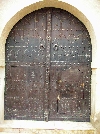
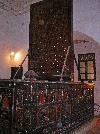 A
later mausoleum is that of Amor b. Salem b. Sa'ab b. Miftah al'Ayari, a.k.a. Sidi Amor Abada Zawiya, a blacksmith and
Sufi teacher from the Ouled Ayar Berber clan. Built in 1872, it with
seven cupola. Oral tradition has woven tales and myths around him.
He was venerated and feared. Perhaps a reflection of the
A
later mausoleum is that of Amor b. Salem b. Sa'ab b. Miftah al'Ayari, a.k.a. Sidi Amor Abada Zawiya, a blacksmith and
Sufi teacher from the Ouled Ayar Berber clan. Built in 1872, it with
seven cupola. Oral tradition has woven tales and myths around him.
He was venerated and feared. Perhaps a reflection of the
 holy
man's perceived tendency towards megalomania. Though he was a normal sized person
the object he created are greatly oversize and quite useless -- except for their
allegorical, metaphorical, entertaining and symbolic
holy
man's perceived tendency towards megalomania. Though he was a normal sized person
the object he created are greatly oversize and quite useless -- except for their
allegorical, metaphorical, entertaining and symbolic
 lessons. The text of the inscriptions
are story of Sidi Amor Abada's life, his wisdom, his origins, his family,
his conception of life, his relations with society and authority. One
such object is a wooden sword and sheath. It has a blunt tip, rounded edge
and is covered with inscription about peace. It is strategically
worth less, but if all weapons in the world followed this design there would
be much less
lessons. The text of the inscriptions
are story of Sidi Amor Abada's life, his wisdom, his origins, his family,
his conception of life, his relations with society and authority. One
such object is a wooden sword and sheath. It has a blunt tip, rounded edge
and is covered with inscription about peace. It is strategically
worth less, but if all weapons in the world followed this design there would
be much less
 carnage
on the planet. He
also created four large anchors to anchor Kairouan so it wouldn't go adrift.
The sea is dozens of miles away and there are no rivers in the vicinity, so
we might assume that Sidi Abada was concern with moral drift of the city.
carnage
on the planet. He
also created four large anchors to anchor Kairouan so it wouldn't go adrift.
The sea is dozens of miles away and there are no rivers in the vicinity, so
we might assume that Sidi Abada was concern with moral drift of the city.
On our visit we found ourselves waiting for better than a half hour for the curator to arrive and open for business. While we waited, a couple of guys passed to and fro with dozens of wheelbarrows full of the fine yellow sand a bit lighter than the color of turmeric (which, by the way, the vendors in the souq sell to tourists as cheap saffron – in fact turmeric is often called the poor man’s saffron). One of the gentlemen tried to help us get into the zaouia, but only roused the night guard. After all the greetings with these two fellows, we parted on very friendly terms when we finally left.
At this point we can again pick up the history of The Sidi Oqba "Great Mosque" of Kairouan, one of the oldest and most
prestigious buildings of the western
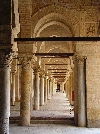 Islamic world. A living museum of
Islamic art and architecture, ancient columns and capitals. Though not
much to look at from outside, the interior is impressive. After the
improvement made in 1023 and the sacking of the city by Beni Hillal, not
much happened until the ceiling and doors were restored again and the
surrounding walls was built in the 17th-19th century. With the wall,
the mosque bases measure 70 and 74 meters, the sides measure 124 and 125
meters. The are eight gates and the entire wall is buttressed.
Islamic world. A living museum of
Islamic art and architecture, ancient columns and capitals. Though not
much to look at from outside, the interior is impressive. After the
improvement made in 1023 and the sacking of the city by Beni Hillal, not
much happened until the ceiling and doors were restored again and the
surrounding walls was built in the 17th-19th century. With the wall,
the mosque bases measure 70 and 74 meters, the sides measure 124 and 125
meters. The are eight gates and the entire wall is buttressed.

 The
courtyard was once tiled with terracotta tile, but
today is paved with marble. The drains are designed to filter and decant
rainwater. The wells have curbs made
from the base of
The
courtyard was once tiled with terracotta tile, but
today is paved with marble. The drains are designed to filter and decant
rainwater. The wells have curbs made
from the base of
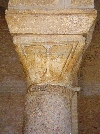 ancient columns. The
water is used for ablution.
ancient columns. The
water is used for ablution.
 The sundial indicates times of prayer. Two
rooms on the western corner were the ancient midha, ritual cleansing. A
capital in the NW corner shows a cross, because Christianity is included in
Islam. The rooms at the northern end were to store mats, cleaning equipment,
oil, and historic artifact.
The sundial indicates times of prayer. Two
rooms on the western corner were the ancient midha, ritual cleansing. A
capital in the NW corner shows a cross, because Christianity is included in
Islam. The rooms at the northern end were to store mats, cleaning equipment,
oil, and historic artifact.
Though as nonbelievers we were not allowed into the prayer room, you can see that it is cavernous with an ornately appointed mihrab (niche that indicates the direction of Mecca) and a large number of columns which were brought from earlier Roman and Byzantine sites.
We had gotten an early start so were ahead of the tourist bus up until this point. Here we got a visual demonstration of how visitors who do not meet the dress requirements (shoulders and legs to below the knees covered) must don a ridiculous looking robe – one young European man was enjoying his notoriety as the only person ignorant of local custom.
 For
those who can visualize size: the pray hall is 37 meters deep and 70 meters wide.
The central aisle is 5.75 meters wide. The aisle along the qibla
(front or transverse aisle) is 6
meters wide. There are eight secondary aisles on each side of the central aisle.
The central and secondary naves (aisle ceilings) are supported by arches
made with ancient columns topped by a springer, an impost and a cornice,
above the capitals. The mihrab cupola marks the crossing of the central and
the transverse naves. A second cupola is above the entrance of the
central aisle. Both are set on shell-shaped squinches. The
maqsura
(an enclosure for dignitaries to pray) can be entered via a door directly in the
qibla wall. The epigraphic band in this masqsura is one of the superb
examples of epigraphic bands in Islamic art. It uses elegant flowers and
braided kufic script sculpted on a background of intertwined plants.
For
those who can visualize size: the pray hall is 37 meters deep and 70 meters wide.
The central aisle is 5.75 meters wide. The aisle along the qibla
(front or transverse aisle) is 6
meters wide. There are eight secondary aisles on each side of the central aisle.
The central and secondary naves (aisle ceilings) are supported by arches
made with ancient columns topped by a springer, an impost and a cornice,
above the capitals. The mihrab cupola marks the crossing of the central and
the transverse naves. A second cupola is above the entrance of the
central aisle. Both are set on shell-shaped squinches. The
maqsura
(an enclosure for dignitaries to pray) can be entered via a door directly in the
qibla wall. The epigraphic band in this masqsura is one of the superb
examples of epigraphic bands in Islamic art. It uses elegant flowers and
braided kufic script sculpted on a background of intertwined plants.
 The
mihrab is a semi-circular niche, crowned by a
wooden semi-cupola. It is covered by twenty-eight floral and geometric
panels of marble set in seven columns of four pieces. The frame of the
mihrab is ornamented with metallic glint ceramic tiles from the 9th C. AD,
imported from Mesopotamia. The minbar (pulpit) is built of ornately carved teak. It has 300
sculpted and assembled pieces. It the oldest dated pulpit of Islamic world.
The
mihrab is a semi-circular niche, crowned by a
wooden semi-cupola. It is covered by twenty-eight floral and geometric
panels of marble set in seven columns of four pieces. The frame of the
mihrab is ornamented with metallic glint ceramic tiles from the 9th C. AD,
imported from Mesopotamia. The minbar (pulpit) is built of ornately carved teak. It has 300
sculpted and assembled pieces. It the oldest dated pulpit of Islamic world.
 Part
of the story of any city that is approaching 1500 years old is renewal.
Walking around the city to this day you can see buildings being demolished and
new buildings rising in the place of old and the streets being rebuilt.
Each plot of land in this town must have a history as thick as "War and Peace."
Part
of the story of any city that is approaching 1500 years old is renewal.
Walking around the city to this day you can see buildings being demolished and
new buildings rising in the place of old and the streets being rebuilt.
Each plot of land in this town must have a history as thick as "War and Peace."
Excerpt from Ralph journal:
"Appetites satisfied for the time being, we
wandered about the median and then outside it looking for a bookstore with
any English language books for Dan since he finished his last one last
night. This is no mean task as it is difficult to find any bookstore, let
alone one with English titles. I lost interest and wandered back into the
median and was soon lost in the maze.

Although I have read tour books where
the authors delight in being lost in the maze of a medina or a souq
or a kasbah or whatever, I was nonetheless surprised at how quickly
it can happen on a no-sun day. When I finally found the old city wall again
and then a bab or gate, I only generally knew where I was and decided
to follow the wall to a more recognizable point. Boy, was my internal GPS
off on this one. Regardless, it was a pleasant walk and I enjoyed getting a
better impression on how people live in the old part of town.
"As I came to the main south gate near our hotel, I passed the large café just without the gate. It was slightly less crowded than all the other times (maybe six or seven) I’ve passed it. And I was again impressed with the sheer number of men just sitting around in the middle of the day. This time for the first time I actually saw two women, but they were both obviously tourists. The location of these cafes is key. They are the most common of all shops, sometimes two or three within the same block, but not all are created equal. This one just out the south gate of the medina is obviously a prime locale, possibly it is the variety and quantity of tourista passing by as this is where the big buses offload their crowds. It must be a bit unnerving for the first time tourist to pass one of these crowded cafes as all the seats at every table face the street in a series of arched echelons like tables at a dinner theater or Vegas supper show and you are the entertainment. When we ride by on our bikes, we even elicit shouts or catcalls sometimes, but I don’t think that happens to women. It might be an interesting study to send a variety of walkers past one of these cafes and gauge the response. I simply don’t know what the results might be."
![]()
![]()
Unique Programs To Special Places For Memories Of A Lifetime!
![]()
![]() Please
write if you have questions, suggestions and comments about our program or want to be
added to Bicycle Africa's mailing list. (Also let us know how you found this site.)
Please
write if you have questions, suggestions and comments about our program or want to be
added to Bicycle Africa's mailing list. (Also let us know how you found this site.)
